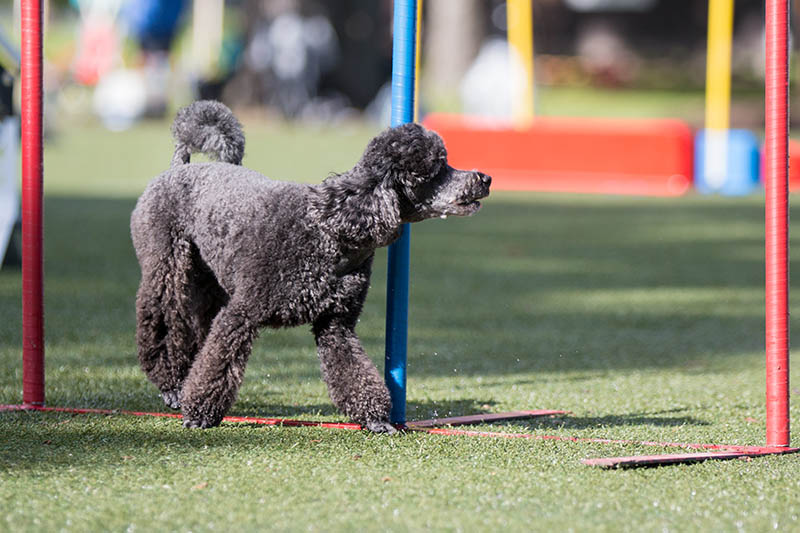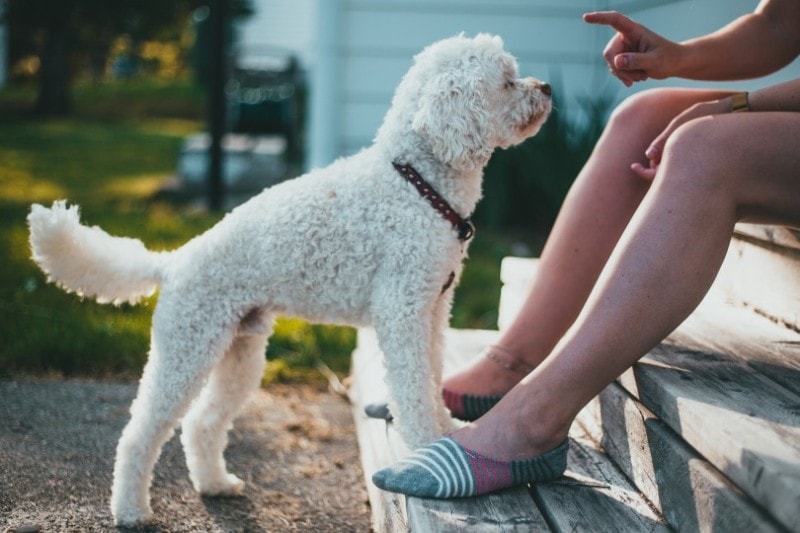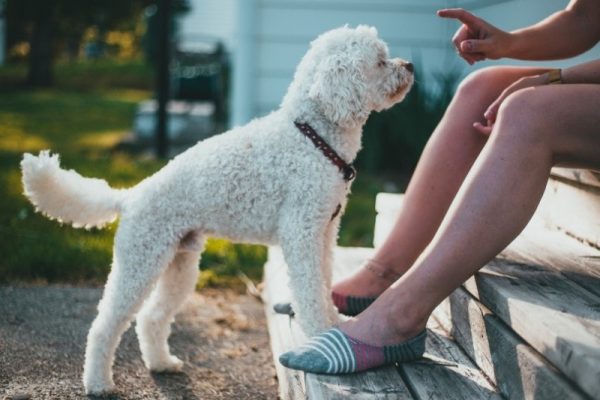Every dog owner knows that training is a key part of helping your pet become a responsible canine citizen. Training can provide plenty of opportunities for dogs to bond with their owners and establish trusted relationships. A strong bond with your dog will help them know their place in your life and in the world at large.
The intelligent poodle loves to engage in training activities because of the mental stimulation it provides, and because they love to earn their owner’s praise. As training can seem like a daunting task, we have gathered 6 tips below that should prove useful when training your poodle.
Before You Start
A key aspect of training your poodle is determining what you’ll be giving your dog to treat them for good behavior. Many pet owners prefer to use small training bites, such as Cloud Star Crunchy Tricky Trainers Cheddar Flavor Dog Treats, as the smaller treats don’t cause their dog’s stomach to fill up too quickly during training activities.
Other owners prefer to use their dog’s food as their training treat, and then skip a meal to keep their pet’s weight optimal. If you don’t want to use food or treats as a reward, you can also designate a toy as a reward that your dog only gets during training.
Different dogs have different motivations, some food, some toys and others praise and patting. Work with your dog’s preferred reward for the most success.
The 6 Tips for Training Your Poodle
1. Sign Up for Training Courses
Many dogs will benefit greatly from joining a puppy, beginner, intermediate, or advanced training class at a training facility in your area. Classes usually cover everything from the basic “sit” command to leash training, and can even address reactivity issues, such as jumping up and lunging at other dogs.
While much can be accomplished by training your dog on your own at home, a professional class teaches your dog, within a controlled environment, that they still need to use their training while interacting with other dogs. Dog training class sizes can range between as few as 4 or 6 dogs, with some classes having upper ranges of 8 to 12 dogs.
Professional classes can also help owners who are struggling with training learn how to interact with their dogs in a way that reduces the frustration that can be felt by both owner and dog during training. If you’re struggling with a specific issue, speak with the instructor before class so they know you need extra help in that area.

2. Schedule Daily Training Sessions
A consistent daily training schedule will help your poodle excel quickly at training activities. Many dogs need a time limit of 10 to 15 minutes in their training sessions to prevent boredom and misbehavior. These training sessions should be fun to keep your dog interested, and you should exhibit excitement to keep your dog engaged. Positive reinforcement with treats, praise, and special toys will greatly benefit your poodle during training sessions, while encouraging a deep, trusting bond between you both.
3. Always End a Training Session on a Positive Note
Ending a training session on a positive note helps ensure a “training is fun!” mentality for your pet poodle. If your poodle is exhibiting frustration and boredom during your training session, it’s better to end it early than to continue the session. Ending a session early may seem like defeat, but if you try again when your dog is more engaged, you’ll have better training outcomes in the long run.

4. Crate Training
While some owners are hesitant to crate train their poodles, it’s actually a very important skill for both you and your dog to master. Crate training is important for many dogs because it helps establish a safe place for them to retreat to when they are tired, feel threatened, or just want some alone time.
It’s important to purchase a crate in which your poodle can freely move around inside. To entice your pup to enter the crate, add comfy bedding, a favorite toy, a treat, or perhaps their food in there. Leave the door open while you’re home to allow them to freely enter and exit.
When your poodle is comfortable with entering and laying in the crate, lock the door and leave the room for a minute. When you return, open the door and give your dog a treat or toy, as well as praise for a job well done. Gradually start leaving your poodle in the crate for longer periods, and always praise and reward the good crate behavior. Eventually, your poodle will become comfortable in the crate and you’ll have a crate-trained dog. Don’t open the crate to let them out if they are digging at it, barking or otherwise actively trying to get out. Wait for a quiet moment, say “yes” and then let your pup out.
5. House Training a Puppy or Adult Poodle
Whether you’re bringing home a puppy or a new adult poodle to your home, setting up a bathroom schedule will help with potty training. Puppies are typically able to hold their bladder for 1 hour for each month that they’re alive—for example, a 3-month puppy should be able to hold its bladder for about 3 hours.
Some puppies may benefit from pee pads set up near their training crate until they’re older and have more control over their bladder. It’s important to set up a schedule based on your puppy’s needs, as some may need to go out more frequently than others. Poodles usually pick up house training easily, but they still need you to show them the way. Whether you have a puppy or an adult dog, setting up a designated bathroom area for your dog will help it remember where to potty when you let it out.
If you have a yard, take your dog to an area away from distractions, such as kids or neighbors, and encourage it to go potty. If you don’t have a yard, find a grassy area while on a walk and encourage your dog to go to the bathroom on that spot. Wait for your dog to eliminate, and reward your dog with a treat or praise for good bathroom behavior.

6. Leash Training
Leash training can be one of the most difficult things for dogs and owners to master, but poodles can excel at walking on a leash if trained properly.
Proper equipment is important for leash training. Some dogs do well with a flat collar, while some prefer the PetSafe Gentle Leader Padded No Pull Dog Headcollar. Other dogs do well with a harness, such as the Halti Nylon No Pull Dog Harness. A non-extendable leash that is roughly 4 to 6 feet in length is perfect for leash training. As dogs tend to get very excited at the idea of a walk, you may need some trial and error with equipment as you figure out what works best for your poodle.
If your puppy or dog is new to leash training, attaching the leash and letting it walk around the home will help it accept the leash. The next step is to take a short walk inside or outside with your poodle, and give it lots of praise during the walk. If your pup begins to pull, stop walking immediately. Start to move forward again as soon as the tension on the leash loosens.
Leash walking may seem like basic training, but it can prove elusive for some dog owners. Walking and heeling are covered in professional training classes, so if you’re having trouble with leash training your pet, you may want to consider signing them up for a training course.
Summing Up
All dogs need to learn their basic commands—like “sit,” “stay,” “down,” “heel,” etc.—as well as potty, crate, and leash training. Pet owners usually find dog training overwhelming at first, and chances are it may be just as overwhelming for your poodle. If professional training classes are within your budget, they will help ease much of the anxiety that both dogs and their owners may experience during this very necessary process.
Featured Image Credit: Erik Mclean, Pexels











